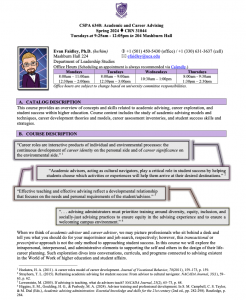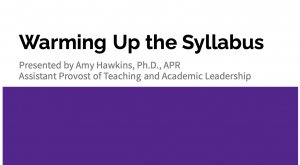 The course syllabus is one of the most important documents of your course–one that sets the stage for student success. It’s a guide for navigating your course and a manual for completing your course successfully. The syllabus is also a fairly reliable indicator of the quality of teaching and learning that will take place in a course (Woolcock, 2006). Therefore, faculty should make every effort to design a high-quality syllabus; one that not only provides necessary information, but also invites and excites students about your course. After all, it is your students’ first exposure to your course!
The course syllabus is one of the most important documents of your course–one that sets the stage for student success. It’s a guide for navigating your course and a manual for completing your course successfully. The syllabus is also a fairly reliable indicator of the quality of teaching and learning that will take place in a course (Woolcock, 2006). Therefore, faculty should make every effort to design a high-quality syllabus; one that not only provides necessary information, but also invites and excites students about your course. After all, it is your students’ first exposure to your course!
Key Components of a Syllabus
Your syllabus should serve as a solid framework for helping you and your students to stay informed and on track throughout the semester. The key components of any syllabus should contain detailed and accurate information about the course; including details from the course catalog, requirements, instructor information, learning activities, and policies. Please review UCA’s Course Syllabus Requirements (from UCA Academic Affairs) for all course syllabi. Additional material may be added at the discretion of the faculty member.
Generally speaking, the following items are considered staple elements for any course syllabus. Although basic, many of these categories can be expanded to be very detailed.
Basic course information
This is the first things students should see in your syllabus. Include the course title, description and overall intent for the course; this will build interest, especially if it's written in student-friendly language. Providing the course goals will also inform the students what they'll be learning throughout the semester.
One final bit of information to include: indicate whether your course is in person or online.
Instructor contact
Students want to know about their instructor! The following is basic information that all syllabi should include:
- Name (including preferred pronouns)
- Phone
- Office location
- Office hours (consider calling these open office or student hours for clarity)
In addition to your contact information, share your preferred method of communication. Whichever your preference, include your availability and response time. Be sure to state your expectations for students as well.
Required materials
List any required books and readings, including software and lab equipment. If your course uses publisher content, be sure to include instructions for getting set up.
Activities and assessments
List all major course activities and assessments, including a brief summary and points possible. Should any activities have rubrics, include them as well.
Policies
UCA's required policies should be listed in your course syllabus. Below, you will find additional recommended policies to include that are specific to your course:
- Attendance and participation
- Grading
- Late work
- Personal electronic devices
- Civility
Course schedule
Provide a week-by-week schedule that includes readings, assignments, assessments, and resources with specific due dates for each week. Presenting this information consistently and in a table format supports usability.
Characteristics of a Well-Designed Syllabus
Think of your syllabus as a learning tool for students; a roadmap that will guide students to success throughout the semester. Students will consult your syllabus for information about due dates, attendance, requirements, and other policies. Designing your syllabus in a way that is usable encourages inclusivity and exhibits visual appeal and warmth that will help your students better navigate the course and positively impact their success.
Sharing her experience and success with designing syllabi, Dr. Cristine Busser, Assistant Professor of Writing, outlines the characteristics of a well-designed syllabus. The entire presentation, “Presenting Your Course: The Well-Designed Syllabus” offers several examples from various UCA syllabi of making your syllabus usable, inclusive, and inviting.
Usable
Usability measures how well a specific user in a specific context can use a product/design to achieve a defined goal effectively, efficiently, and satisfactorily. Traditional syllabi are very text-heavy and hard to read. Make your syllabus easy to read and accessible.
Specific strategies:
- Use an organizational structure (Headings, styles, bulleted lists).
- Exchange text for visual representations of information (icons, graphs, images).
- Maintain a consistent layout (font size, font type, color, spacing).
- Create the course schedule in a table format.
Inclusive
The students in your class come from a variety of backgrounds. An inclusive syllabus incorporates specific language and strategies that are designed to foster a classroom environment that is welcoming and inclusive to all students. It also “includes policies and resources that help to ensure all students are supported in their learning” (Finley, 2021).
Specific strategies:
- Write in plain language by breaking down academic “lingo.”
- Include a genuine statement in which you promote inclusive learning and what that means to their success.
- Build in flexibility within your attendance policy and deadlines (be sure to explain your rationale).
Inviting
Most likely, you’ll be sharing your syllabus on the first day. By writing your syllabus in an inviting and respectful tone, you can help students to feel personally connected to the course as well as seem more approachable. While the content may contain departmental/university requirements and policies, you can still create an inviting impression through the tone in your writing and through using visual appeal.
Specific strategies:
- Replace “the student” with “you” (e.g., “You will learn about XYZ.”)
- Shift your language from cold language to warm language (e.g., “It is important that you attend every class. Otherwise, you will miss out on XYZ.”)
- Invite students to come to your office hours and explain what they gain from connecting with you. Providing flexible options will also meet the needs of students.
- If you are requiring students to submit printed assignments (versus digital submissions), consider adding to your syllabus the note that the Student Government Association (SGA) offers free printing of up to 25 pages per day in the SGA office located in the Student Center.
Setting Your Students Up to Succeed
Beyond the key components of a syllabus are additional factors that help students become more effective learners in your course. Dr. Amy Hawkins, Assistant Provost of Teaching and Academic Leadership, offers tried-and-true strategies that will contribute to that success in her presentation, Warming Up Your Syllabus.
Exemplary Syllabi
Whether you’ve been tasked with creating a new syllabus or refining your own, CETAL has compiled a list of several exemplary syllabi from UCA faculty representing various disciplines. If you would like to submit your syllabus, please reach out to aamy@uca.edu.
BIOL 1440: Principles of Biology 1 (Fall 2022)
MATH 1496: Calculus 1 (Fall 2021)
ACAD 1300: Journeys to Success (Fall 2021)
Additional Resources
Syllabus Checklist to Support Student Belonging & Achievement
Teaching: Who is your syllabus for?
Constructing a Learner-Centered Syllabus: One Professor’s Journey
Does the Document Matter? The Evolving Role of Syllabi in Higher Education
Student Impressions of Syllabus Design: Engaging Versus Contractual Syllabus
7 Ways to Craft an Inclusive Syllabus Design
Finley, D. (2021, April 28). Inclusive Syllabus. American Psychological Association. https://www.apa.org/ed/precollege/psychology-teacher-network/introductory-psychology/inclusive-syllabus
Woolcock, M. J. V. (2006). Constructing a syllabus. Providence, RI: Brown University, Harriet W. Sheridan Center for Teaching and Learning.

